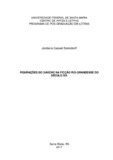| dc.creator | Steindorff, Jordana Cassel | |
| dc.date.accessioned | 2020-01-16T15:52:03Z | |
| dc.date.available | 2020-01-16T15:52:03Z | |
| dc.date.issued | 2017-12-07 | |
| dc.identifier.uri | http://repositorio.ufsm.br/handle/1/19384 | |
| dc.description.abstract | Much has already been said and much remains to say about the inhabitants of Rio Grande do Sul. Regionalism, as an artistic current inspired by regional links, has always advocated for the preservation of the cultural and artistic heritage of the remote regions of Brazilian immensity. In the extreme south, it pointed in the letters, riding a representative type in affirmation, to perpetuate a retempered history by an ethnic horizon perfectly identified with geography. From the mix of different peoples, of those who arrived in the Província de São Pedro with those who were native here, sprouted, adorned by the pampas exuberance, the gaucho’s figure. This type wandered from a pejorative connotation, from clandestinity and poverty, to the rank of trooper, warrior and even hero. Our objecctive, in this research, is to develop an analysis from two literary pieces, in order to reflect and demonstrate the interventions that these productions have exerted to the gaucho's figuration. We believe in the authenticity of this work precisely for investing in a period which gaucho’s myth was being formed. We define as the corpus this work A divina pastora (1992), by José Antônio do Vale Caldre e Fião, and O vaqueano (1973), by Apolinário José Gomes Porto Alegre, since both authors significantly worked to the elaboration and development of a literary system in Rio Grande do Sul. Our research question consists in problematizing how nineteenth-century writers, especially the members of the Partenon Literário society, undertook the emancipation movement of regional literature, constructing the gaucho figuration in Rio Grande do Sul’s fiction. This temporal cut is justified by the political transformation existing in Brazil and, consequently, in Rio Grande do Sul in this period. Therefore, we suppose that fabric in this process, the gaucho’s social type is taken by literature as a hero, which includes values such as honesty, loyalty and bravery. Consequently, the analysis of the reality’s fictional transpositions makes possible the recomposition of the collective imaginary’s particularities from a time in the past, characteristics that take for granted an altered identity, that began to compose a symbolic world. | eng |
| dc.description.sponsorship | Coordenação de Aperfeiçoamento de Pessoal de Nível Superior - CAPES | por |
| dc.language | por | por |
| dc.publisher | Universidade Federal de Santa Maria | por |
| dc.rights | Attribution-NonCommercial-NoDerivatives 4.0 International | * |
| dc.rights.uri | http://creativecommons.org/licenses/by-nc-nd/4.0/ | * |
| dc.subject | Ficção rio-grandense | por |
| dc.subject | Século XIX | por |
| dc.subject | Figuração | por |
| dc.subject | Fiction rio-grandense | eng |
| dc.subject | Century XIX | eng |
| dc.subject | Figuration | eng |
| dc.title | Figurações do gaúcho na ficção rio-grandense do século XIX | por |
| dc.title.alternative | Gaucho’s figurations in fiction rio-grandense of century xix | eng |
| dc.type | Dissertação | por |
| dc.description.resumo | Muito já foi dito e ainda há muito que dizer sobre os habitantes do Rio Grande do Sul. O regionalismo, enquanto corrente artística inspirada nos elos regionais, sempre preconizou pela preservação do patrimônio cultural e artístico das regiões remotas da imensidão brasileira. No extremo Sul, apontou nas letras engarupado em um tipo representativo em afirmação, para eternizar uma história retemperada por um horizonte étnico perfeitamente identificado com a geografia. Do caldeamento de diferentes povos, dos que chegaram à Província de São Pedro com os que daqui eram nativos, brotou, enfeitada pela exuberância dos pampas, a figura do gaúcho. Esse tipo peregrinou de uma conotação pejorativa, haja vista sua clandestinidade e pobreza, para o posto de tropeiro, guerreiro e, até mesmo, herói. Nosso intuito, nesta pesquisa, é desenvolver uma análise a partir de duas obras literárias, a fim de refletir e demonstrar as intervenções que essas produções exerceram sobre a figuração do gaúcho. Cremos na autenticidade deste trabalho, justamente, por investir em uma época em que o mito do gaúcho estava sendo formado. Definimos como corpus as obras A divina pastora (1992), de José Antônio do Vale Caldre e Fião, e O vaqueano (1973), de Apolinário José Gomes Porto Alegre, uma vez que ambos os autores atuaram significativamente na elaboração e desenvolvimento de um sistema literário no Rio Grande do Sul. Nossa questão de pesquisa consiste em problematizar como os escritores do século XIX, em especial os integrantes da sociedade Partenon Literário, empreenderam o movimento de emancipação da literatura regional, construindo a figuração do gaúcho na ficção rio-grandense. Esse recorte temporal justifica-se pela transformação existente no Brasil e, por consequência, no Rio Grande do Sul nesse período. Assim, supomos que tecido nesse processo, o tipo social gaúcho é tomado pela literatura como um herói, que comporta valores como honestidade, lealdade e bravura. Logo, a análise das transposições ficcionalizadas da realidade torna viável a recomposição das particularidades do imaginário coletivo de um tempo de outrora, características que tomam por verdade uma identidade alterada, que passou a compor um mundo simbólico. | por |
| dc.contributor.advisor1 | Santos, Pedro Brum | |
| dc.contributor.advisor1Lattes | http://lattes.cnpq.br/8231452052035761 | por |
| dc.contributor.referee1 | Baumgarten, Carlos Alexandre | |
| dc.contributor.referee1Lattes | http://lattes.cnpq.br/9047211743126405 | por |
| dc.contributor.referee2 | Fonseca, Orlando | |
| dc.contributor.referee2Lattes | http://lattes.cnpq.br/4423966413352509 | por |
| dc.creator.Lattes | http://lattes.cnpq.br/5581271068921513 | por |
| dc.publisher.country | Brasil | por |
| dc.publisher.department | Letras | por |
| dc.publisher.initials | UFSM | por |
| dc.publisher.program | Programa de Pós-Graduação em Letras | por |
| dc.subject.cnpq | CNPQ::LINGUISTICA, LETRAS E ARTES::LETRAS | por |
| dc.publisher.unidade | Centro de Artes e Letras | por |



